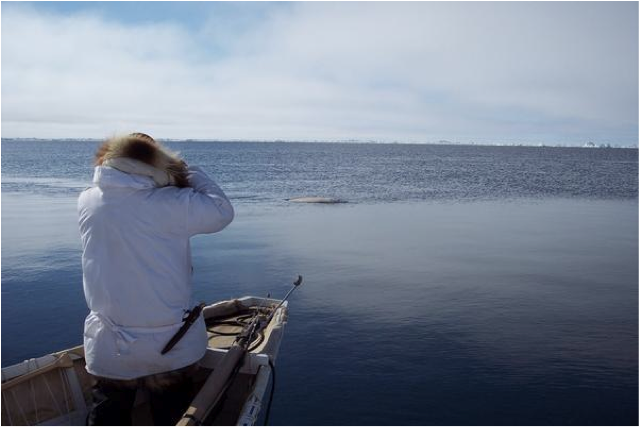September 10thWe received a question from one of the six schools around the world following Icebreaker Healy on our twenty-three day expedition. A sixth grade class from Happy Hollow in Indiana asked the following question: “Do all the scientists aboard the Healy believe in the global warming theory? If not, how many don’t?” ------------Our earth is going through one of the many phases of Global Climate Change, which includes the warming of the planet’s 'air conditioning system' - the Arctic and Antarctic areas. More specifically for the Arctic region in Northern Alaska, much of the impacts of 'global warming' for this region can be seen through the environmental changes brought on the diminishing old (multi-year) sea ice extent. Satellite imaging carried out by NASA and the National Snow and Ice Data Center shows that 40 percent of our multiyear ice has rescinded between 2005 and 2007. In my opinion, there is no room to argue that an environment that has been cold for nearly 10,000 years is going through a heat stroke. The planet’s various ecosystems operate naturally together like the many systems in a body would. What happens when a body gets overheated? It does not operate normally as it should. The ocean ice has supported Inuit communities for many reasons, a few being walrus hunting and spring whaling. Subsistence hunters harvest an average of 5,000 Pacific Walruses each year, and have reached anywhere from 3 to 16 thousand harvests annually as seen in the fifty years of data provided by the U.S. Fish & Wildlife Service. Every part of the walrus is used for feeding the local communities, while the skins and bones are used for things such as blankets and crafts. (U.S. Fish & Wildlife Service, page 4) The walruses depend on the thickness and availability of multi-year ice; ice that has been around for numerous years and is on average about 9 feet thick. This kind of ice grows thicker along the coast, which supports walruses and hunting crews. One walrus alone can weigh up to 4,000 pounds. In November of last year, the Federal Marine Mammals Commission offered a recommendation to continue investigations that would lead to listing the Pacific walrus population as endangered. Female walruses haul out on the drifting sea ice in order to give birth, nurse their young, rest, and gain access to their food sources. In 2007, thousands of walruses were beached while their access to food was limited due to the thinning ice. This caused mothers to become thinner and increased stampeding among the herds, which caused the death of many baby walruses. What was the cause of the beaching and stampedes? I believe it is climate change.
Whaling is also very important to northern communities, who bring in an about 50 bowhead whales per year. The whales caught average about 30 to 70 feet in length and weigh about a ton per foot. You can imagine how much more meat this brings into the communities! The spring and fall whaling seasons also help set the tone for the rest of the year in Arctic whaling communities. Nalukataq, the whaling festival, happens in late June every year, where hunters distribute tons of meat and the community members are thrown into the air using a blanket that is made from the seal skin of the boat that landed the whale. This is symbolic of a successful whaling season and brings the community together. The meat is also distributed during Thanksgiving and Christmas, marking successful years. The year 2006 yielded the lowest spring harvest of bowhead whales in the past 35 years, according to the annual report issued by the International Whaling Commission. They noted that the “difficult ice and weather conditions challenged hunters during the spring.” The loss of sea ice negatively affects the spring whaling season, since whalers have to be more careful to not camp on the thinning parts of the ice, and the local search and rescue organizations have to increase their oversight during the season. What difficult ice and weather conditions were they talking about? From NASA's satellite imagery, one can see that the older, thicker multi-layer ice declined, replaced by newer, thinner seasonal ice. The first-year ice is typically 6 feet thick (or less), several feet thinner than the multi-year ice, and more vulnerable to the summer melt. Today, people of the north still make their way out onto the pack ice and tundra to set up hunting camps, like they have for millennia. The northern Inuit hunting culture has existed for thousands of years and has lived off of the ice and ‘harsh’ Arctic environment. Even today, seventy percent of foods in most Inuit households come from subsistence hunting. Fish, seals, walruses, beluga and bowhead whales are hunted among other things, providing tons of food, as well as materials for things like the boats, jackets and blankets used. Hunting brings everyone together. It is a huge part of education and development in the North, and the entire Northern lifestyle evolves around community hunting activities. The health of the walrus and bowhead whale are intrinsically tied to the health of the Northern communities. It is not surprising that the 40 percent loss of multi-year ice coverage between 2005 and 2007 contributed to the anomaly of beached and trampled walruses in 2007 and the very low spring whaling season of 2006. For too long, American communities have become comfortable within the capitalistic world market. Many of us live our lives, within the comforts of our own homes, without thinking about where our energy is coming from and where the pollution is going. The Northern Inupiat hunting lifestyle is being threatened by the shrinking and weakening of sea ice. Who carries the burden of the warming Arctic temperatures while others benefit from the over-usage of fossil fuels?
Last updated: September 29, 2010 | |||||||||||||||
Copyright ©2007 Woods Hole Oceanographic Institution, All Rights Reserved, Privacy Policy. | |||||||||||||||

